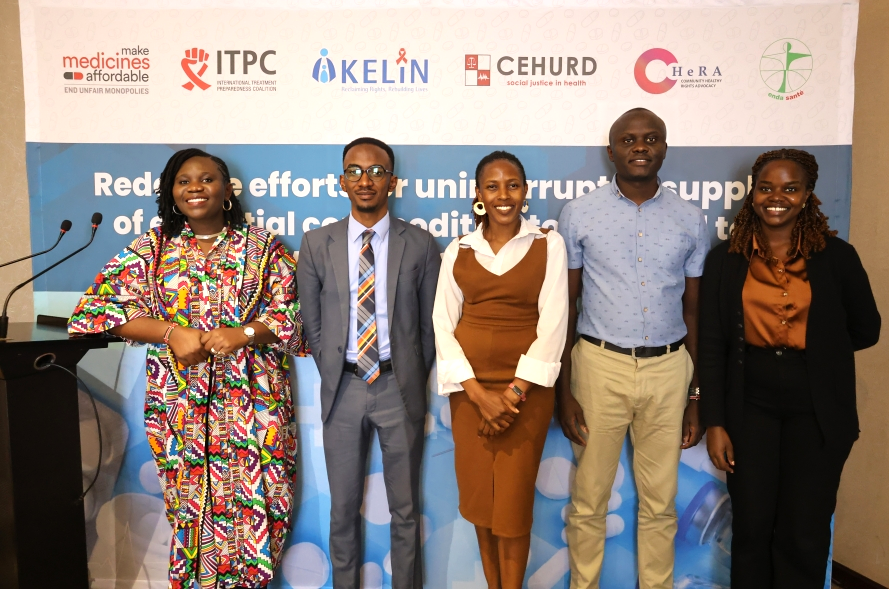The Turning Point
Uganda’s healthcare landscape is at a critical juncture. As international funding streams face unprecedented uncertainty, the country must urgently transition from donor dependence to domestic sustainability in medicines and health products. This was the central theme of the National Dialogue on Access to Affordable Medicine & Health Products, held on June 24, 2025, in Kampala.
The dialogue, convened by CEHURD in partnership with KELIN and supported by ITPC Global, brought together key stakeholders to address the mounting challenges posed by recent US policy shifts, including withdrawal from WHO and potential PEPFAR funding cuts. With over 70% of Uganda’s health commodity funding historically coming from donors, the implications are stark and immediate.
The dialogue builds on the findings of a recent Market Intelligence Study on priority HIV and TB products in Uganda [A1] , which found that the governments contribution to the health commodity budget particularly HIV, TB, and HCV treatments is lacking, while recommending that the government should reduce dependency on International donors through the development of sustainable funding strategies to cover gaps as donor priority pivots to Climate Change and other Global Challenges.
The Scale of the Challenge
Kenneth Mwehonge from HEPS-Uganda delivered sobering statistics during his keynote presentation. The US currently provides 63% of global HIV funding, while in Africa, only South Africa allocates the recommended 5% of its budget to health – everyone else falls short. Uganda’s dependence runs deeper than many realize, with Essential Medicines and Health Supplies (EMHS) representing the second-largest health sector expenditure after human resources.
The numbers paint a concerning picture: over 46% of Uganda’s commodity budget for FY24/25 remains unfunded, creating a funding gap of nearly $500 million. Critical areas like Non-Communicable Disease commodities face a 99.6% funding shortfall, while STI/OI medicines show a 90.3% gap.
Industry Perspectives on Local Manufacturing
Dr. Adrian Kivumbi from the Uganda Pharmaceutical Manufacturers’ Association highlighted both progress and persistent challenges in local production. Uganda now boasts 26 registered pharmaceutical companies with over $500 million invested, yet the sector struggles with financing constraints. Notably, 70% of the health budget remains donor-funded, creating vulnerability when products like Lumartem begin disappearing from shelves.
The path forward, according to Kivumbi, lies in three strategic areas: partnerships, Intellectual Property reform, and pricing strategies. He pointed to successful models in India, where local manufacturers receive government protection, and noted growing interest from major pharmaceutical companies like Novartis and Pfizer in providing affordable medicines to African markets.
Intellectual Property: Barrier or Bridge?
James Lubwama from the Uganda Registration Services Bureau provided crucial insights into intellectual property challenges. The fundamental issue isn’t just awareness but the strategic use of technical ambiguities in patent applications that make drug reproduction nearly impossible without specialized knowledge.
Uganda has shown leadership in implementing IP flexibilities, with over 200 drug patents blocked from registration annually. The country’s IP office maintains over 117 million documents and offers enhanced protection for both drug compounds and manufacturing processes. However, ongoing international discussions about delinking research costs from manufacturing costs remain critical for sustainable pricing.
Government Response Strategy
Dr. Martha Ajulong from the Ministry of Health outlined the government’s multi-pronged approach to building resilience. The ministry is implementing the Hub and Spoke model to improve hospital accountability and has secured new funding to fill gaps left by USAID, including ongoing recruitment to address human resource shortages.
The EAC pool procurement mechanism, negotiated in March 2025 in Kigali, offers promising opportunities for collaborative purchasing power. However, Ajulong acknowledged that regional mechanisms face challenges, including mistrust among member states and preference for EU suppliers over supporting regional partners.
Funding Transition and Regional Cooperation
Diana Tibesigwa from AIDS Healthcare Foundation emphasized the need for strategic conversations about remodelling global funds and determining national priorities. Her key question resonated throughout the dialogue: “How do we negotiate debt for health?”
Uganda’s membership in the African Union and East African Community presents opportunities for leveraging pool procurement mechanisms, yet implementation remains slow. The digitization of health systems and supply chains down to community levels represents a critical sustainability strategy for projects previously supported by international donors.
Innovation in Quality and Manufacturing
The National Drug Authority has demonstrated remarkable progress, growing from 6 manufacturers in 2010 to 56 today, including 32 drug manufacturers, 5 traditional medicine manufacturers, and 19 medical device manufacturers. The authority is now pursuing GAP (Good Manufacturing Practice) maturity level 3, indicating serious commitment to international quality standards. However, knowledge gaps persist among healthcare providers who often prefer foreign products despite locally manufactured alternatives being equally effective and more accessible.
A Critical Moment for Action
The dialogue concluded with a clear recognition that Uganda stands at a crossroads. The transition from donor dependence to domestic sustainability is no longer optional – it’s urgent. As Kenneth Mwehonge emphasized in his closing remarks, “Uganda can no longer afford to wait or wish for donor aid to last forever. We must seize this moment to rebuild our health supply chain around resilience, equity, and innovation.”
The path ahead requires unprecedented coordination between government, private sector, civil society, and regional partners. Success will depend on Uganda’s ability to transform this crisis into an opportunity for building a more resilient, locally owned healthcare system that serves all citizens effectively.
With the right political will, strategic investments, and collaborative partnerships, Uganda can emerge from this funding crisis stronger and more self-reliant than ever before. The dialogue has set the stage – now comes the critical work of implementation.
For more information, please contact:
Seth Nimwesiga | Legal & Policy Advocacy Officer
Center for Health, Human Rights and Development (CEHURD)
Website: www.cehurd.org and
Pesa Okania | Programme Officer – HIV, TB and KAPs -Kenya Legal and Ethical Issues Network on HIV & AIDS (KELIN)
E-mail: okaniapesa@kelinkenya.org
Website: www.kelinkenya.org


